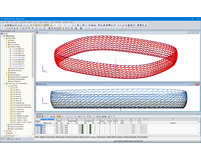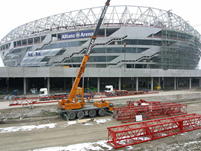Engineers faced the task of turning the architectural vision of the architects of Herzog & de Meuron from Switzerland into reality. Structural engineering and design posed special requirements for the engineers.
Structure and Dimensions
The wall facade of Allianz Arena in Munich is a steel structure covered by foil cushions. It consists of a spatially curved structure that encloses the external side of the solid structure in an elliptical shape, with a height from +40.68 ft to 143.5 ft above the playing field level. The ellipsis radius is 426.5 ft and 377.3 ft, and the circumference is about 8,717 ft. The central part of the steel structure is a rhombic grid.
The grid is mainly supported by rigid brackets arranged radially on the solid structure or on the primary steel, which are pin-joined to the grid.
The covering of the ventilated facade consists of 768 pneumatic ETFE cushions in the shape of rhomboids that are connected to rectangular tubes. Also, 96 cushions form a ring around the whole stadium. Eight ring cushions build up the wall facade. Each cushion is connected to two horizontal and two diagonal frame beams. The seamless design of the structural grid allows for effective detailing of the cushions.
Structural design
When developing the structure, the aim was to minimize the loads due to restraints in the steel structure. The main causes of the effects due to restraint are the temperature differences in the steel structure as well as the movement of the structure, which was built in eight independent construction stages.
In order to reduce the effects due to restraint, normal force hinges were used in almost all crossing points of the steel grid. Deformation of the normal force hinge was limited to avoid damaging the cushions in the case of the substructure deformation. Since this was considered in the designed result combinations, some of the hinges took the effects and rigid connections were generated at the corresponding locations.
For the representation of complex structural behavior, an iterative calculation according to the second-order analysis was performed, taking into account the entire structure form without stresses.
With the kind support of
Christian Würfl, Gerhard Fessler
Project managers of Allianz Arena by IPL GmbH
| Structural Engineering | Facade IPL Ingenieurplanung Leichtbau GmbH formTL ingenieure für tragwerk und leichtbau, Radolfzell, Germany www.form-tl.de Solid Construction Arup Associates London, UK www.arup.com |
| Architect | Herzog & de Meuron Basel, Switzerland www.herzogdemeuron.com |
| Construction | General Contractor Alpine Bau Deutschland AG, Eching, Germany General Planner HVB Immobilien AG, München, Germany www.hvbimmobilien.com |
| Investor | Allianz Arena - Munich Stadium GmbH allianz-arena.com |



